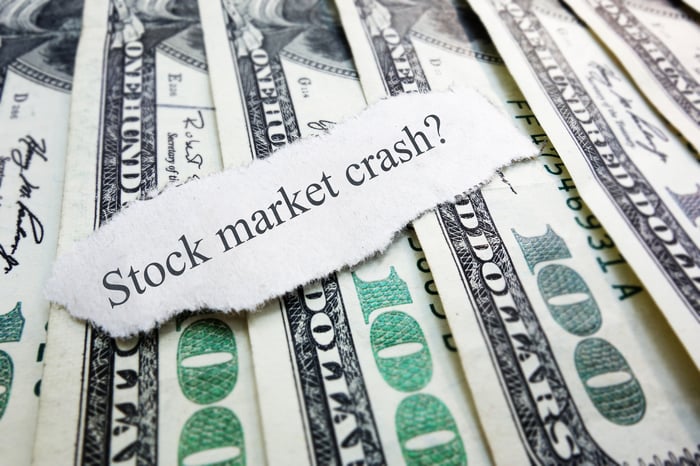January provided a not-so-subtle reminder that stock market crashes and corrections are a normal part of the investing cycle, and they can occur without warning. Both the benchmark S&P 500 and growth stock-driven Nasdaq Composite endured their steepest corrections in close to two years.
While steep moves lower in the market in a short time frame can be unnerving, arguably one of the smartest ways to save your portfolio from these periods of heightened volatility is to buy high-yield dividend stocks (i.e., those with yields of 4% or above).
Dividend stocks offer a number of advantages to investors. For instance, companies that pay a dividend are often profitable on a recurring basis and time-tested. Additionally, income stocks have a rich history of handily outperforming their non-dividend-paying peers.

Image source: Getty Images.
If this recent sell-off does turn into a full-blown stock market crash, the following high-yield dividend stocks can be your saviors.
AT&T: 8.3% yield
If you crave stability, telecom stocks like AT&T (T 1.12%) are a good place to find it. AT&T has two key catalysts that can deliver modest organic growth over the next half decade, all while the company parses out an above-average payout.
For starters, ongoing upgrades to 5G wireless infrastructure are going to be a big deal. Even though the investments AT&T is making in wireless infrastructure are sizable, consumers and businesses have been waiting a decade for an upgrade to wireless download speeds. The rollout of 5G speeds in the U.S. should encourage businesses and consumers to replace their devices over the coming years. Since data is what drives AT&T's juicy wireless margins, faster download speeds can increase the wireless segment growth rate.
The other growth catalyst for AT&T is the expected spinoff of content arm WarnerMedia, which will be merged with Discovery. This new media entity will offer a larger content library with over 85 million pro forma subscribers, and should result in at least $3 billion in annual cost synergies. Most importantly, AT&T will be able to modestly reduce its dividend following the spinoff and focus on debt reduction. Even after this dividend cut, AT&T should still offer a hearty yield of around 5%.

Image source: Getty Images.
Enterprise Products Partners: 7.9% yield
With the economic chaos caused by the pandemic still fresh in many investors' minds, the idea of an oil stock providing "safety" to a portfolio during a crash might be laughable. But most oil and gas companies can't hold a candle to Enterprise Products Partners (EPD -0.17%) and its nearly 8% yield.
When crude oil demand experienced a historic drawdown in 2020, most upstream companies (drillers and explorers) were slammed. Enterprise Products Partners is a midstream company. It owns around 50,000 miles of oil and gas transmission pipeline, 19 natural gas processing facilities, and has approximately 14 billion cubic feet of natural gas storage space.
The beauty of this operating model can be seen in the way the company structures its contracts with drillers. With volume and price commitments in place well in advance, Enterprise Products Partners has a good bead on how much cash flow it'll be generating looking out multiple quarters. This cash flow predictability is the key to undertaking new infrastructure projects without compromising its profitability or 23-year streak of increasing its base annual payout.
It's also worth noting that at no point during the crash in crude oil prices in 2020 was Enterprise Products Partners' dividend in danger of being cut.

Image source: Getty Images.
Philip Morris International: 4.8% yield
Another high-yield dividend stock that can save your portfolio during a stock market crash is global tobacco giant Philip Morris International (PM -0.49%). Philip Morris sports a yield of nearly 5%, with management intent on paying out a significant portion of annual profits as a dividend.
Three factors are responsible for making this company such a rock-solid investment in virtually any economic environment. First off, tobacco contains nicotine, which is an addictive chemical. These addictive properties allow the company to pass along price increases that help it outpace any volume declines it might be contending with in developed markets.
Second, Philip Morris' geographic diversity is playing a big role. This is a company that's operating in more than 180 countries worldwide. If regulations are tightening in one market, chances are a burgeoning middle class looking for simple luxuries, like tobacco products, are making up the difference in an emerging market.
And third, Philip Morris is looking beyond its traditional tobacco lineup with its IQOS heated tobacco system. Through the first nine months of 2021, it held a close to 7% share of the heated tobacco market in countries where IQOS is sold (excluding the U.S.).

Image source: Getty Images.
Annaly Capital Management: 11.3% yield
Among ultra-high-yield stocks, few can provide more stability to your portfolio during a stock market crash than mortgage real estate investment trust (REIT) Annaly Capital Management (NLY 1.42%). Annaly has paid out north of $20 billion in dividends over the past quarter of a century and has averaged a yield of around 10% for the past two decades.
Mortgage REITs like Annaly are attempting to borrow money at low, short-term lending rates, then using this capital to purchase higher-yielding long-term assets, like mortgage-backed securities. The difference between the yield the company receives and its average borrowing rate is known as "net interest margin." The larger the net interest margin (NIM), the more profitable Annaly can be.
The good news here is Annaly has hit the sweet spot of its growth cycle. During the early stage of economic recoveries, it's not uncommon for the yield curve to steepen. When this difference in yield between short-and-long-term Treasury bonds widens, the company's NIM tends to rise.
What's more, over 90% of Annaly's asset portfolio is agency securities. These are assets backed by the federal government in the event of default. This added protection is what allows the company to deploy leverage to maximize profits and maintain its double-digit yield.

Image source: Getty Images.
AbbVie: 4.1% yield
A fifth high-yield dividend stock that can save your portfolio if a market crash strikes is pharmaceutical stock AbbVie (ABBV -3.78%). Although AbbVie's 4% yield pales in comparison to the likes of Annaly, bear in mind that the former's share price has more than doubled over the past 2.5 years.
There's little question that anti-inflammatory drug Humira is the superstar of AbbVie's product portfolio. Through the first nine months of 2021, Humira brought in $15.4 billion of the company's $41.2 billion in net product sales. If not for the COVID-19 vaccines, Humira would be the world's top-selling drug. Despite facing biosimilar competition in Europe, Humira can remain AbbVie's cash cow for years to come.
On top of organic innovation, AbbVie hasn't been afraid to turn to acquisitions to diversify its revenue stream and boost its long-term growth potential. In May 2020, the company made a splash with its cash-and-stock deal to acquire Allergan. This deal added new lines of revenue (e.g., aesthetics and eye care), as well as a brand-name blockbuster in Botox.
Since people don't get to choose when they get sick or what ailment(s) they develop, demand for pharmaceuticals tends to remain steady in any economic environment. That makes healthcare stocks like AbbVie a solid bet to outperform during a market crash.





